Buying a monitor? Please refer to this post before purchasing.
New user? Register here.
- AuthorPosts
- February 27, 2021 at 7:27 am #63616
 Gigamike
GigamikeFrom reading another post you made you said the G27Q has a low haze value.
“These concepts are explored in our matte vs. glossy monitors article. I haven’t seen them myself, but some models use a new AUO panel and could be worth considering as they may have a lower ‘haze value’ even if the screen surface texture isn’t as smooth. The cheapest current model to use these panels is the Gigabyte G27Q.”
The panel model seems to be AUO M270DAN02.BUO, which according to Panelook seems to be 25%, which is no different than most IPS panel types.
I am also very sensitive to anti glare coatings. My current AG241QX has a grainy appearance, but the text is very clear regardless. No sharpening setting to speak of and most 27 inch monitors i compare it to are always blurrier and use a panel that has 25% haze listed in panel look. I’ve tried a lot of them too.
How does this compare to the m27q? It looks to me based on rtings that the haze value is smaller considering the picture they have of the AG coating.
Would the m27q have a lower haze value than the g27q? And would a similar haze value monitor appear the same in terms of added “blur” and clarity loss between monitors? From my testing it appear so.
I’m interested in your thoughts on this.
Thanks for your time.
February 27, 2021 at 7:47 am #63622 PCM2
PCM2Hi Gigamike,
Don’t pay any attention to haze values listed on Panelook. And it isn’t a concept I like to refer to much in reviews as it can confuse people given how it’s listed by some sources, even though I do reference it in the matte vs glossy monitors article. I’m glad you brought up the AOC AG241QX, because that is firmly what I’d classify as medium (regular) matte anti-glare. This classification is my own system, as somebody highly sensitive to screen surface, and is based on how ‘layered’ the image appears plus the glare handling of the screen surface. The two always go hand in hand, to some degree. Mod edit: AOC confirmed this to be “25%+ haze” as explained in my subsequent post. Screen surface smoothness (how ‘grainy’ the image appears) is a separate factor, although typically comes alongside a layered appearance on medium matte anti-glare screen surfaces. For reference the image below is the AG241QX switched off in a moderately bright room and this is typical glare handling for a medium matte anti-glare surface.
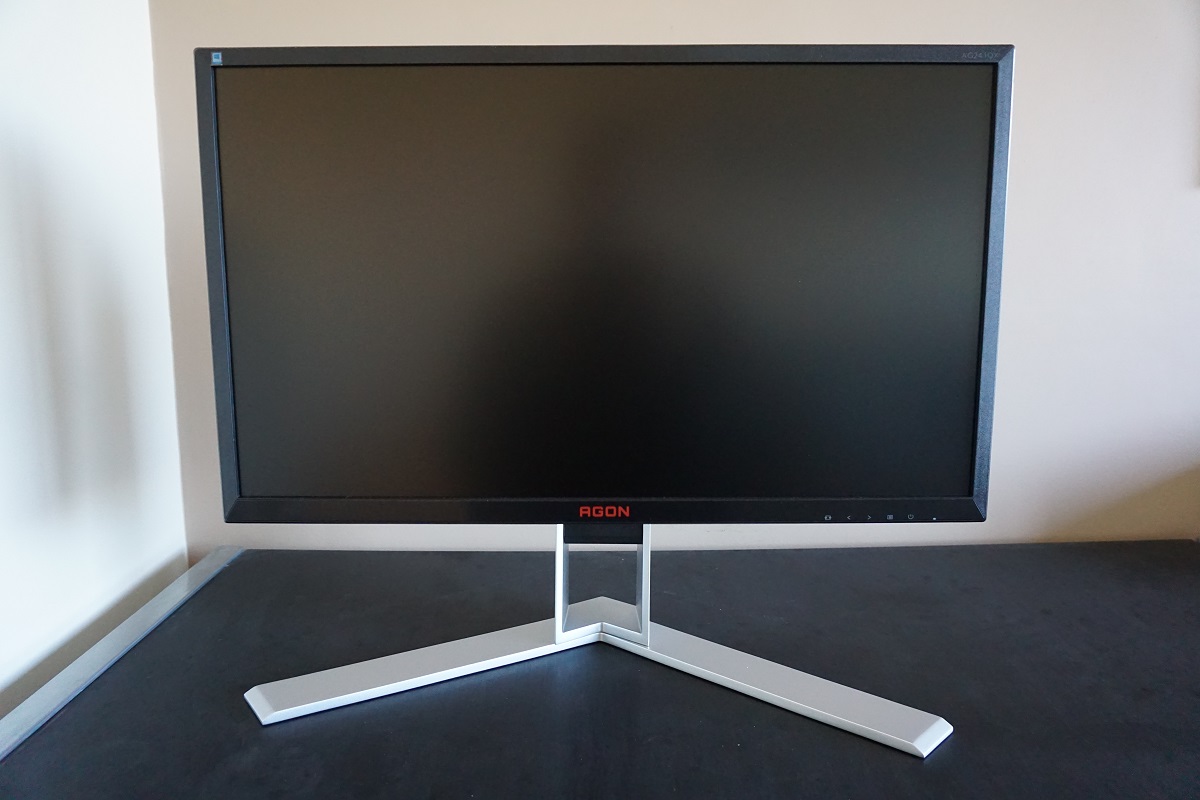
Now I haven’t actually seen the G27Q myself, but that comment regarding supposed haze value was based on what I’d seen from some other AUO panels recently and many other WQHD IPS models for that matter. Some of which are also listed as ‘25% haze’ for some reason despite them being firmly what I’d classify as light or very light matte anti-glare. I’m not aware of any high refresh rate 27″ WQHD models that have the same graininess or layering as the AOC AG241QX, incidentally. The AOC has a significantly tighter pixel density due to the 23.8″ vs. 27″ screen and same WQHD resolution – this has a positive impact on how clearly defined things appear. These benefits would be amplified somewhat if a lighter screen surface were used, but certainly exist regardless of that. The M27Q‘s screen surface I found agreeable for reasons noted in the review. And here’s the screen switched off in a moderately bright room, for reference.
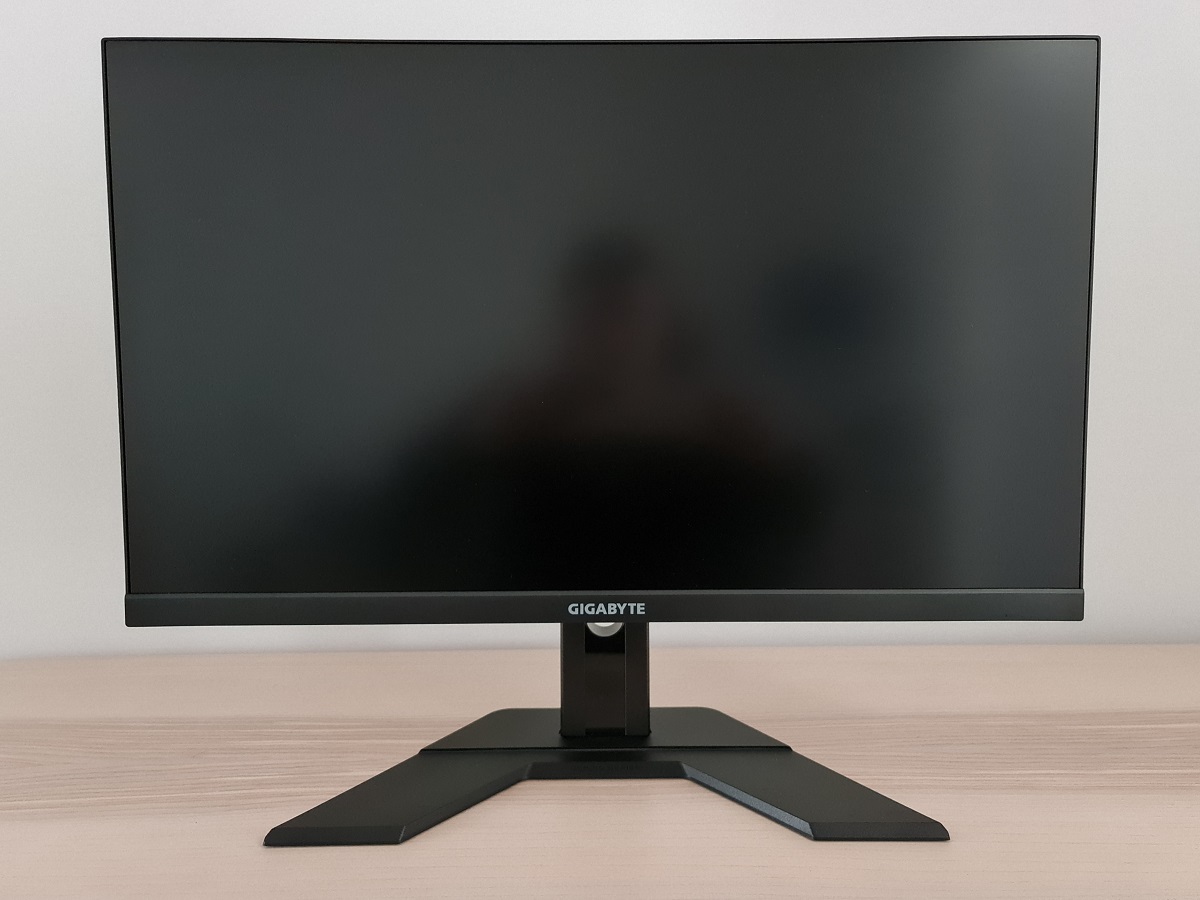
The screen surface is lighter and less grainy than that of the AG241QX, which should be clear not just from these photos but also the commentary surrounding both models in their respective reviews. It’s tough to say how the G27Q compares, but I don’t see that as relevant given that both models offer a much smoother and lighter screen surface than the AOC. The Gigabyte M27Q is a superior model to the G27Q in my book anyway, the pixel responsiveness is superior and better-tuned. Without the same standout weaknesses for some pixel responses or as much overshoot (especially at decreased refresh rates). Plus a higher maximum refresh rate. The colour gamut is also a touch broader in the green region, giving some shades a more vibrant appearance. Although it’s less generous for some red shades, which actually keeps it from ‘overdoing’ skin tones and reddish browns as much.
The subpixel layout is really the only area I feel the M27Q falls down compared to competitors, but as I note in the review this is only something a minority of users will take issue with in practice. And just as a final note of caution – don’t pay too much attention to screen surface from macro photos. Screen surfaces are complex 3D structures and the tiniest shift in focal depth will completely change how things appear in such photos. For reference, both photos below were taken on the BenQ EX2710 (light matte anti-glare on this – AUO panel incidentally) with slightly different focal points.
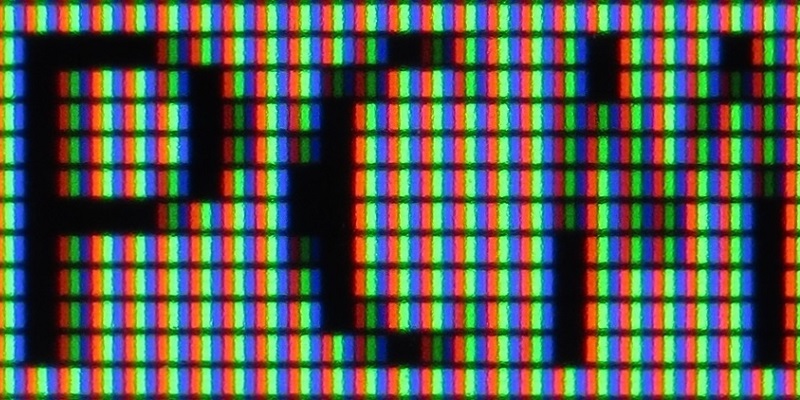
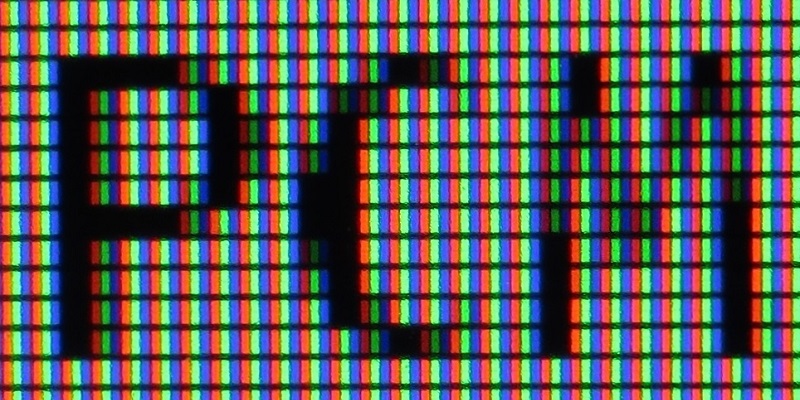 February 27, 2021 at 2:27 pm #63659
February 27, 2021 at 2:27 pm #63659 GigamikeFebruary 27, 2021 at 2:33 pm #63661
GigamikeFebruary 27, 2021 at 2:33 pm #63661 PCM2
PCM2AOC, directly, when we reviewed the monitor. Actually they said 25%+ so it could be higher. This was specifically as I was discussing why they didn’t opt for the lighter finish seen on the S2417DG. I’ve also had confirmation from BenQ engineers that this is the typical haze value they target for their XL series models. This was a while ago and may not apply universally, but strong glare handling is always a focus there. And it’s very typical for ~24″ high refresh rate TN and even IPS-type models to use this sort of medium matte anti-glare screen surface. Consider the AUO M250HAN01.6 and M250HAN01.7 used on the likes of the Acer XB253Q GP. The image below shows that model in a fairly bright room. Panelook also specifies 25% haze there.
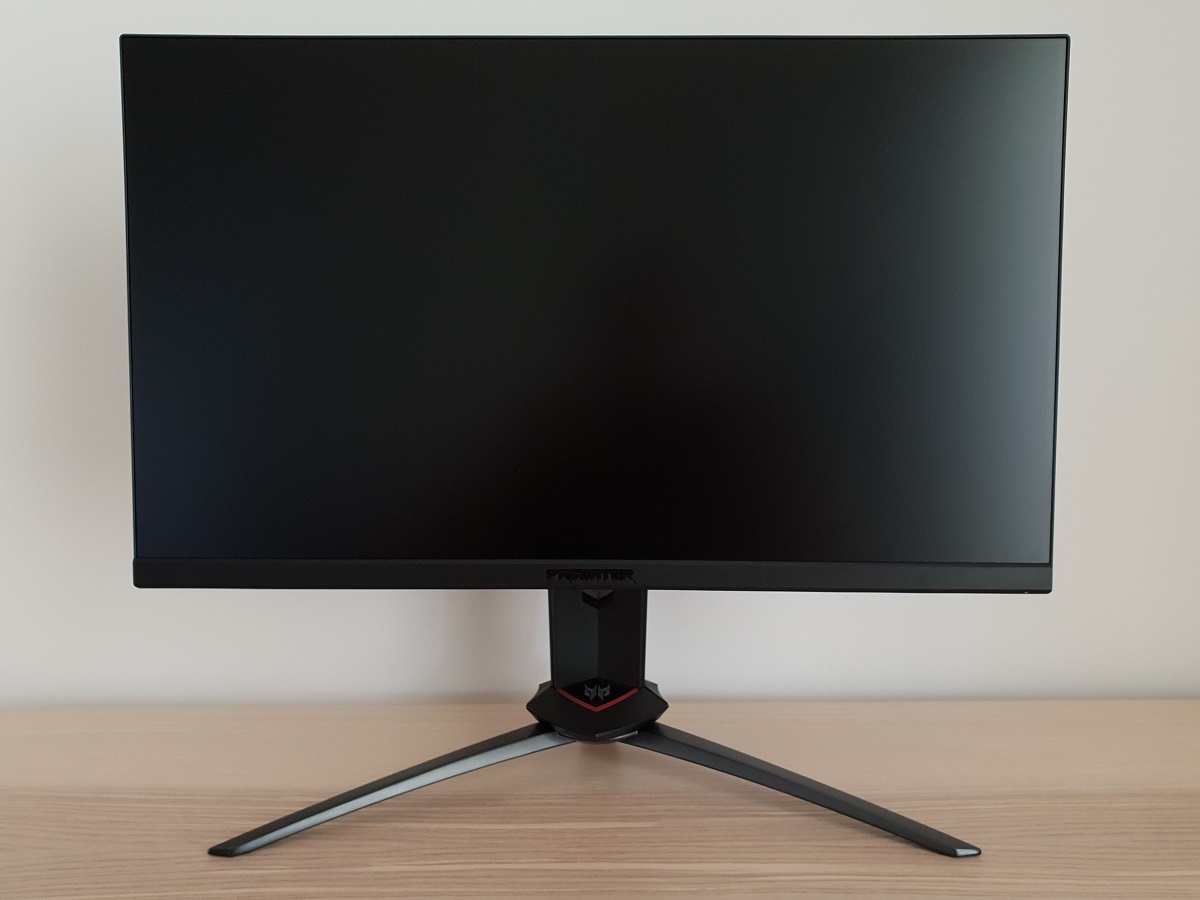
And just to round things off, here’s the BenQ EW3280U which uses the AUO M320QAN02.1. Also has a specified 25% haze value on Panelook, but the screen surface is clearly extremely different to the XB253Q GP. The pictures don’t really do this justice and I appreciate the lighting conditions aren’t exactly the same in each case. But the descriptions of the screen surface and how it affects the image in the reviews serves as an appropriate reference. Seeing the interaction of light with the screen off at various angles is also quite revealing, which you can see in the ‘Features & Aesthetics’ section of our video reviews. The point here is simply that you can’t rely on these specified haze values, the EW3280U is clearly the ‘lighter’ screen surface here. Panels with an apparent 25% haze value according to Panelook seem to vary greatly in practice when it come to glare handling and screen surface lightness. It can also be complicated by the fact some manufacturers will use panel ‘subvariants’ or have the panels re-surfaced before they’re used in their products, which can alter the haze value. This isn’t all that common but does happen from time to time.
 February 27, 2021 at 5:27 pm #63662
February 27, 2021 at 5:27 pm #63662 Gigamike
GigamikeThat makes sense. IM half convinced its pixel density, but i can’t be sure. I did have the hp omen 27i side by side w/ my ag241qx and i swear that its not just pixel density that’s at play here that adds to sharpness. I resized pictures (played around w/ it) on both monitors to increase sharpness and I know I could still see a difference in image clarity.
Perhaps its a bit of placebo, ill admit, but i feel as if there is a “blur filter” on the 27 inch and not on the 24. Text looks clear on the 24 inch through all the grain it adds. There isn’t a need to sharpen it like on the 27 inch versions. I know one has higher pixel density but, again, I’m not yet convinced that’s the subtle difference.
And w/o knowledge of actual haze values, its hard to compare.
Anyway, one last question.
How would you say the clarity compared between the m27q and the ag241qx? If that’s at all possible.
If not, thanks for the help.
February 27, 2021 at 5:29 pm #63664 PCM2
PCM2I’ve already covered that. To summarise; the screen surface is lighter and less grainy on the M27Q vs. the AOC AG241QX, therefore offers superior clarity potential. The pixel density is significantly different between the two and I linked to my take on that and what it would do for the experience. You shouldn’t underestimate the potential impact this could have on the perceived clarity, as I said earlier. I’m not why you would exclude that based on the fact you resized images, that doesn’t change the pixel density of a given display and it’s still going to have an impact.
Another thing to consider would be the ‘fringing’ of the M27Q which is covered extensively in the review and I referenced in an earlier reply. And aside from that, the sharpness algorithms or filters of some models may be more to your taste than others – Gigabyte models offer a sharpness control and by default the sharpness level is nice and neutral. So they offer decent flexibility in that respect really.
February 27, 2021 at 6:38 pm #63666 Gigamike
GigamikeI understand where you’re coming from, but im still not convinced its just density. Though i could be wrong. I admit.
Changing the image size will change the number of pixels used to display it and can “equalize” to some degree the clarity given similar mattes w/ similar haze values. As larger sizes on the 24 inch would equate to smaller sizes on the 27 inch due to scaling.
It also makes sense that similarly hazed valued monitors will look better on a higher density monitor than not. Perhaps that’s what I’m seeing. In which case a larger and lower haze valued 27 inch would be better.
Thanks for your help
February 27, 2021 at 6:44 pm #63669 PCM2
PCM2As I’ve covered, the AG241QX has a worse screen surface than your typical 27″ WQHD IPS model (and certainly the M27Q). So it loses out when it comes to clarity in that respect. Therefore I don’t really see a logical explanation for what you’re observing on the AOC vs. 27″ models other than the pixel density difference. Enlarging an image doesn’t necessarily nullify the pixel density difference, especially if you’re talking about an enlargement to make things a similar size on a ~24″ and 27″ screen of a given resolution. You will still have edges of objects or other features within the image that are more clearly defined with a superior pixel density. This is certainly the case for higher resolution image content and is why high pixel density monitors can be useful for photo editing and image manipulation even if a lot of time is spent zoomed into finer details on the image.
I suggest you try the M27Q, though, because you don’t really have any compelling ~24″ alternatives with the resolution. And a lighter screen surface certainly aids the clarity regardless of pixel density, even if it isn’t a substitute for a higher pixel density. If you want a superior pixel density without compromising on speed you’d find that through high refresh rate ‘4K’ UHD options. Which are obviously in a different league when it comes to pricing and take a much beefier system to run at suitably high frame rates.
March 24, 2021 at 7:04 am #63961 mario24601March 24, 2021 at 7:05 am #63963
mario24601March 24, 2021 at 7:05 am #63963 PCM2
PCM2They’re quite similar really. As per comments in their respective reviews (PA278QV as reference), I found both quite agreeable. The Gigabyte I consider slightly ‘lighter’ (lower haze) which is why I categorised it as ‘light to very light’ vs. just ‘light’. But the ASUS had the slightly smoother screen surface finish if anything, with the Gigabyte having a fine ‘misty’ graininess as described in the review. But I wouldn’t say it’s a dramatic difference really and most users would struggle to tell much if any difference with how the image is presented due to screen surface even if they had them side by side.
March 24, 2021 at 5:12 pm #63980 mario24601
mario24601Thank you! Appreciate your insight! Very helpful.
March 30, 2021 at 6:11 pm #64079 mario24601
mario24601Thanks for all the recent help PCM! Your site is great and full of useful info. I was recently looking for a replacement 27 1440p for my Apple Cinema Display. I wanted something glossy, similar, but sadly I do not see any manufactures making glossy displays any longer. After reading a lot here, I went with the Asus PA278CV. I also tried LG 27UN850-W. I ended up returning the LG. 4K was just too small for me even with scaling on MacOS. The Asus is good. Color and bright ness are good. I am not sure I notice it being less anti glare than something like the LG I tried. Maybe a little but nothing I can really say for sure. While the Asus is fine, I’m not 100% happy, just because I miss the glossy “pop” and really want something even less anti glare/matte. Do you have any recommendations on anything else I can try? I don’t game, so super high refresh rates are not necessary but 75 hertz plus would be good. I run this on a Mac Pro with RX 580. Would the Gigabyte M27Q best more ‘glossy” or what else would you recommend? Thank you!
March 30, 2021 at 6:14 pm #64082 PCM2
PCM2As per my previous reply, the M27Q I’d classify as ‘light to very light’ so in that respect it is a bit closer to the glossy side of things than the ASUS. I think it would be worth a try. Whilst it really isn’t the same thing as a glossy screen, it’s about as close as you’re going to get to that really. Unless you’re open to the Dell Alienware AW2721D, which I’m sure you’d feel is overkill and too expensive to consider. Glossy screen surfaces have very much fallen out of favour I’m afraid. I wish there were glossy options I could recommend but there simply aren’t.
April 12, 2021 at 8:53 pm #64193 mario24601
mario24601Hello! So far I have tried M27Q, PA278CV, 27UN850, and S2719DGF. They all have pros and cons. The M27Q was nice but text was a little too blurry, I’m guessing due to the pixel layout. The PA278CV was also nice but wish it was more glossy. Any other recommendations, something with light matte, 1440p or 4k, and higher than 60 hertz if possible? Thank you.
April 12, 2021 at 8:56 pm #64195 PCM2
PCM2No, there’s nothing I’d recommend above what you’ve just tried there. I suggest you decide which compromise you are best able to live with, because no monitor is perfect and some of those models are better than most in many respects. Especially the ASUS and Gigabyte. Did you tune ClearType appropriately on the M27Q as advised in the review?* It won’t make things perfect as covered, but it will help. You should also give yourself more time to get used to that or indeed some of the other issues you have with the other monitors. It’s certainly possible to adapt to such issues, especially if you use a given monitor in isolation rather than putting it under the microscope with side by side or consecutive comparisons.
I’ve received some positive feedback about the models using 28″ ‘4K’ Innolux AAS (IPS-type) panels in terms of screen surface, but I’ve yet to see it myself. This was based more on it not being overly grainy rather than it being very ‘light’ or low haze. I’d say similar things about the models with 27″ Panda panels I’ve used such as the 276E8VJSB and 279P1. I may be looking at the Philips 288E2UAE (288E2E) shortly. I’ve been more impressed by the screen surface on the ~32″ ‘4K’ IPS models such as the BenQ EW3280U in terms of both lightness and being relatively smooth. For the 27″ models I don’t consider them superior to the ASUS you tried and didn’t quite find ‘light’ enough.
*Edit: Never mind, you have a Mac system so ClearType isn’t an option. You’re running without any particular subpixel optimisations if you’re a Mac user.
April 12, 2021 at 10:35 pm #64197 PCM2
PCM2Actually, I’ve thought of a possible alternative. If you’re happy to compromise with 2560 x 1440 @60Hz, you might quite like the BenQ PD2705Q.
April 14, 2021 at 5:37 pm #64206 Pauline
PaulineI hope you don’t mind me giving some user feedback as I have some experience with some of these models as well in combination with MacOS.
@ mario24601: You said in one of your previous post: I also tried LG 27UN850-W. I ended up returning the LG. 4K was just too small for me even with scaling on MacOS.
It’s strange that even with scaling you found that the font was too small. In fact, you can scale a 27″ 4K monitor to a 2560 x 1440 resolution in MacOS, which is exactly the same as the native resolution of the ASUS PA278CV. But the big advantage you have with a 27″ 4K monitor scaled to 2560×1440 in MacOS is that the font will be a lot sharper and smoother than a native 27″ 2560 x 1440 resolution. This is due to changes in anti-aliasing in MacOS (since Mojave), which makes the text on a non 4K monitor always more blurry/fuzzy in comparison to a 4K monitor. At the moment I’m using the 27″ 4K Philips 278E1A scaled at 2560×1440 and text is a LOT sharper than my older non 4K 27″.
I’m very sensitive to a grainy screen surface, but it’s quite OK on the Philips compared to a lot of other monitors I tried. The only one that has a much better screen surface is the one that Adam mentioned, the Benq EW3280U. But there you will have less pixel density than with a 27″ 4K, so that might make a difference in sharpness of text depending on how far away you sit from the screen.
Hope this helps.
April 19, 2021 at 7:17 am #64245 mario24601
mario24601Yes, of the models I have tried the Asus was probably the best though I do wish it was a little brighter. For me on Mac, running Mac Pro with 96GB ram and RX 580 8GB GPU with dual Xeon CPUs. The scaling on the 4K was ok, though compared to the 1440p monitors it was a little small unless I bump it up to 1080p which they gets crazy big. Also the scaling may cause more stress on the GPU but not certain about this. Maybe if I went 32 in 4K or even 5K that would solve the size issue but not certain if it would make my problem worse. You are happy with the Philips? I keep hearing about a glossy screen model that should be coming out soon. On my desk, screen is about arms length or about 20-22 inches. I’ve been playing with moving it closer or slightly further away but haven’t found the sweet spot. Maybe if I go 4k 32 and upscale to 1440p might be a good options for me, or 5K? Unclear about what to try next.
April 19, 2021 at 7:25 am #64248 PCM2
PCM2Scaling in this context is simply a software-based process so doesn’t tax the GPU, specifically. Don’t confuse scaling in the OS with interpolation or GPU scaling. On Windows you can select any scaling you want between 100% (no scaling) and 500% scaling, although the standards would be increments of +25% (some examples in our good old ‘4K’ article). Does MacOS not have a setting that would make things look like a 2560 x 1440 monitor? 150% scaling in other words. There should be, unless you’re using an old version of the OS perhaps. Or anything between that and making things look like a Full HD model (200%)?
I’m also a bit confused about your comments saying you wished the PA278CV was a little brighter. It has a 350 cd/m² specified maximum luminance and I measured a bit above that on the PA278QV. As RTINGS did on the PA278CV. That’s in line with the other models you’ve tried, too. And do you actually run these monitors at full brightness? Unless you were using it via USB-C where the brightness may be reduced to maximise PD (just theorising here, not sure it does this). Perhaps you’re talking about the perceived ‘pop’ etc. due to screen surface, which might make sense given the initial comments and discussions in this respect.
The glossy model you’re referring to is presumably the Philips 328M1R, which is a VA model and therefore apples to oranges compared to the others you’ve tried. Also note my observations regarding subpixel related issues there on the early sample I tried. May or may not still be the case.
- AuthorPosts
- You must be logged in to reply to this topic.
